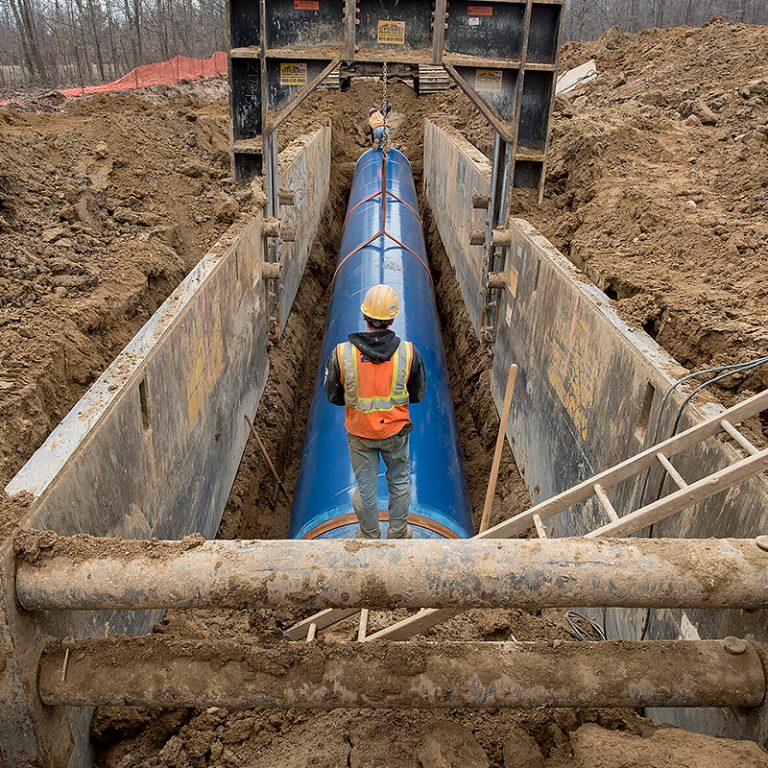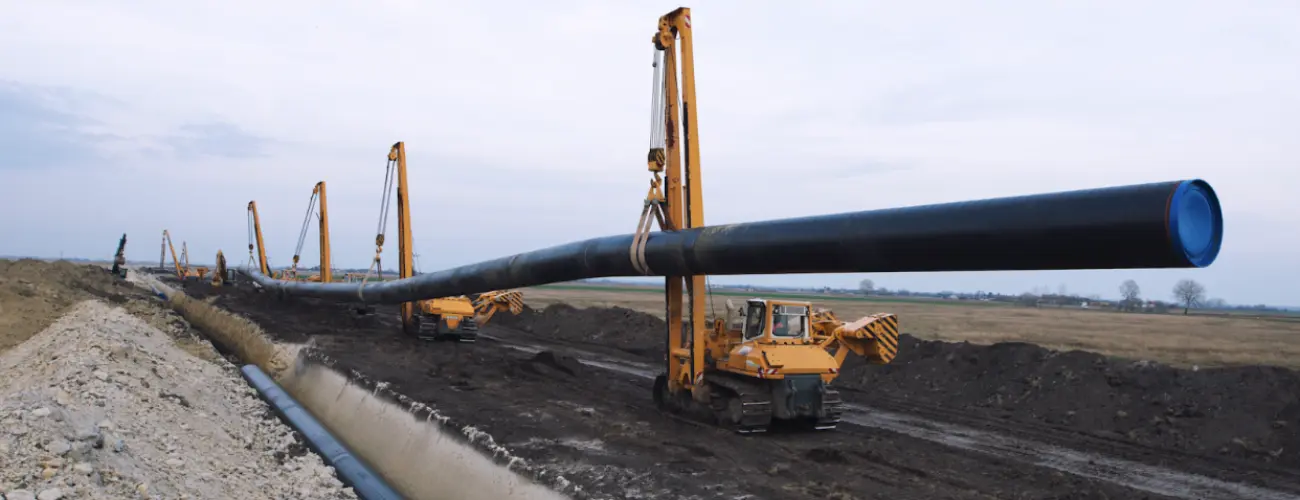Boost Efficiency With Strategic Creek Pipe pipeline construction Methods
The Significance of Pipeline Construction: Checking Out the Solutions Supplied in the Industry
Pipeline construction is a crucial part of contemporary framework. It promotes the transportation of essential sources like oil, gas, and water. The industry encompasses different services, consisting of preparation, site prep work, and installment. Each phase requires accuracy and adherence to safety and security criteria. As neighborhoods depend upon these systems for their incomes, recognizing the ins and outs of pipe construction discloses its significance and potential challenges. What elements affect the success of these tasks?
Overview of Pipeline Construction Services
Pipeline construction services include a series of specialized tasks designed to facilitate the installment of pipes for delivering various materials, including oil, gas, and water. These solutions typically consist of site preparation, excavation, setup of pipe sections, and backfilling. Skilled labor and innovative tools are essential for guaranteeing each stage is performed with precision and safety.Safety procedures are vital, as these projects often entail collaborating with dangerous products and in tough atmospheres. Quality assurance procedures establish that the pipes meet industry standards and regulations. In addition, the solutions may include trenchless modern technology, which reduces surface area disruption.Environmental considerations play a substantial duty in pipe construction, needing analyses and mitigations to shield surrounding ecological communities. On the whole, pipeline construction solutions are essential for establishing the framework essential for power and water distribution, sustaining both economic development and societal requirements.
Preparation and Design in Pipeline Projects
Reliable preparation and design are critical parts of effective pipe tasks, guaranteeing that all elements are thoroughly dealt with before construction begins. This stage includes detailed feasibility researches that evaluate the technical, financial, and environmental elements influencing the task. Designers and developers team up to create in-depth plans that outline the pipeline route, materials, and construction methods, straightening with regulatory demands and market standards.Advanced software application and modeling techniques are often employed to imitate various scenarios, enhancing the layout for performance and safety and security. Environmental influence evaluations are performed to reduce potential damage to environments and communities, reflecting a commitment to lasting methods. Additionally, stakeholder engagement is necessary, promoting communication and attending to worries from impacted parties. Inevitably, effective planning and style established the structure for a pipeline project, lessening threats and making certain a structured construction process, inevitably contributing to the general success of the procedure.
Website Prep Work and Excavation
Detailed website preparation and excavation are vital steps in the pipeline construction process. This stage includes a thorough assessment of the land where the pipeline will be mounted. Job groups perform studies to identify soil types, topography, and existing energy lines to assure a risk-free and effective excavation. Appropriate website preparation minimizes environmental influence and facilitates smoother construction operations.Excavation adheres to, where heavy equipment is used to remove soil and rock, developing a trench that fulfills the specified deepness and width for the pipe. This procedure has to stick to security regulations and environmental standards to avoid damages to bordering ecosystems.Additionally, disintegration control procedures are executed to stabilize the website throughout and after excavation. Effective site preparation and excavation add considerably to the total success of pipeline tasks, laying a strong structure for the subsequent phases of construction.
Pipeline Installation Methods
Pipeline installation techniques are important for the effective execution of framework jobs. 2 popular approaches consist of trenchless modern technology, which reduces surface area disruption, and the open-cut excavation procedure, known for its straightforward strategy. Each method uses distinct benefits and considerations relying on job demands and ecological elements.
Trenchless Technology Techniques
While typical techniques of pipe installation usually entail substantial excavation, trenchless innovation techniques provide an extra effective and eco-friendly alternative. These ingenious techniques, such as straight directional drilling and pipe bursting, decrease surface area disturbance by permitting for the installment of pipes without substantial excavating. This not only reduces the ecological effect yet likewise significantly reduces labor and restoration expenses. Trenchless methods help with the installation of pipelines in urban locations where typical excavation would be unwise or damaging to existing facilities. In addition, these methods can fit various soil types and conditions, making them versatile options for pipe construction. Eventually, trenchless modern technology represents a substantial innovation in the pipe sector, advertising sustainability and operational effectiveness.

Open-Cut Excavation Refine
Open-cut excavation stays an essential method in pipe installation, defined by the straight excavation of a trench to lay pipelines. This technique involves getting rid of dirt and other products to develop a trench of adequate depth and width, allowing for the placement of pipelines at the required quality. Open-cut excavation is typically liked for its cost-effectiveness and simplicity, specifically in areas with secure dirt problems. It can disrupt surface area tasks and requires mindful preparation to handle web traffic and environmental influences. Safety actions must be carried out to safeguard employees and close-by facilities throughout the excavation process. Overall, while open-cut excavation might not appropriate for all terrains, it continues to be an extensively made use of approach in pipeline construction.
Evaluating and Quality Control
Examining and quality control are crucial parts in pipe construction, ensuring that installments fulfill recognized safety standards and performance requirements. Various inspection strategies and approaches are utilized to evaluate material quality and adherence to governing conformity. This methodical method aids recognize prospective problems before they escalate, protecting the integrity of the pipe system.

Inspection Techniques and Methods
Assessment techniques and techniques are essential parts in making sure the stability and safety of pipe construction. Numerous techniques, consisting of aesthetic examinations, ultrasonic screening, and radiographic examinations, are used to discover defects and validate high quality. Visual evaluations permit the recognition of surface anomalies, while ultrasonic screening uses acoustic waves to assess wall density and locate imperfections internally. Radiographic exams involve X-rays or gamma rays to create photos of the pipeline's framework, revealing surprise concerns. Additionally, pressure testing is carried out to review the pipeline's honesty under operational conditions. These approaches collectively add to an extensive understanding of the pipe's problem, enabling prompt upkeep choices and making certain compliance with market requirements. Efficient evaluation is critical for preventing failings and promoting long-lasting operational safety and security.
Safety Criteria Conformity
Making sure conformity with security criteria is vital in pipe construction, as it directly affects the job's general high quality and dependability. Following recognized guidelines and standards guarantees that construction practices minimize dangers connected with pipe installment and procedure. Creek Pipe Texas oilfield. Extensive screening procedures, including non-destructive screening and pressure analyses, are critical in validating that pipelines can hold up against the functional stress and anxieties they will certainly come across. Quality guarantee measures are also essential, as they establish a structure for constant surveillance and evaluation throughout the construction procedure. By focusing on safety standards compliance, companies not just safeguard workers and the environment however also improve the integrity of the pipeline, ultimately bring about lasting functional success and public trust fund in the facilities
Product Quality Analysis
Product high fix a leak plumbing quality analysis plays a considerable duty in the total honesty of pipe construction. This procedure entails rigorous testing and quality control measures to ensure that materials meet market standards and specs. Numerous examinations, including tensile stamina, deterioration resistance, and weld stability assessments, are performed to recognize any type of possible weaknesses. A complete examination not just ensures the performance of the pipe yet additionally improves safety and sturdiness over its life expectancy. Additionally, executing quality control methods assists reduce risks associated with material failures, which can cause expensive fixings and ecological risks. By prioritizing worldly top quality examination, business can assure conformity with regulatory requirements while fostering confidence among stakeholders in the dependability of their pipe systems.
Maintenance and Repair Service Solutions
Repair and maintenance solutions play an important function in the durability and effectiveness of pipe systems. These solutions encompass normal assessments, troubleshooting, and rehabilitative actions to deal with damage, leaks, and other problems that may develop in time. Competent professionals make use of innovative technologies such as ultrasonic screening and clever pigging to keep an eye on pipeline integrity, making sure that any potential issues are identified early.Additionally, upkeep programs commonly consist of set up preventative actions created to boost system reliability and lower the chance of unforeseen failings. Repair services might involve the substitute of damaged areas, securing leakages, or using trenchless technology for marginal disruption.
Environmental Conformity and Precaution
Pipeline systems not only call for recurring repair and maintenance to function effectively however additionally must follow stringent environmental conformity and safety actions. These guidelines are crucial for lessening eco-friendly effect and making certain public security. Firms in the pipeline construction sector carry out comprehensive ecological assessments prior to project initiation, recognizing potential dangers to wildlife and ecosystems.Furthermore, adherence to security methods safeguards employees and surrounding neighborhoods. This consists of regular training on emergency situation feedback and spill prevention techniques.To keep compliance, markets make use of keeping an eye on technologies to identify leaks and various other abnormalities in real-time. Environmental monitoring underground water leak plans are typically created to lay out steps for attending to unforeseen problems during construction.Ultimately, rigorous adherence to ecological compliance and security procedures not just meets legal obligations however also fosters sustainable methods within the market, advertising an equilibrium in between facilities development and environmental stewardship.
Frequently Asked Questions
What Profession Opportunities Are Available in Pipeline Construction?
Job chances in pipeline construction encompass duties such as task managers, engineers, welders, and safety examiners. These placements require varied trenchless pipe repair near me abilities, offering pathways for development in an essential field of infrastructure advancement and power circulation.

Exactly How Do Pipeline Projects Impact Local Communities?
Pipeline projects greatly influence regional communities by affecting economic development, offering job possibilities, and improving infrastructure. They might additionally elevate issues regarding ecological impacts, land usage, and potential disturbances to community cohesion and all-natural ecosystems.
What Modern technology Is Used in Modern Pipeline Construction?
Modern pipeline construction uses innovative technologies such as GIS for mapping, drones for aerial studies, and automated welding systems to boost effectiveness, safety and security, and precision, eventually facilitating the efficient transport of sources across numerous surfaces. Creek Pipe trenching services.
Just How Are Pipeline Construction Costs Estimated?
Pipeline construction prices are estimated through comprehensive evaluations of products, labor, devices, and governing needs. Aspects like surface, task dimension, and ecological factors to consider additionally greatly influence the total spending plan and economic preparation for construction.
What Are the Largest Challenges in Pipeline Construction Projects?
The biggest challenges in pipeline construction projects consist of governing conformity, ecological worries, logistical problems, protecting financing, and handling labor lacks. Each aspect can greatly affect timelines and spending plans, making complex the overall implementation of the job.